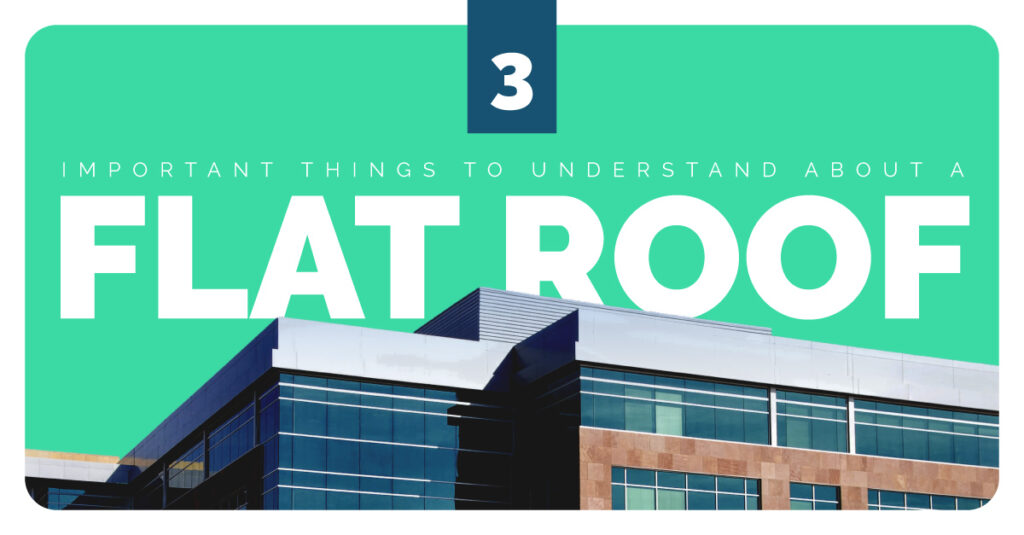
Although flat roofs are relatively rare on residential buildings, they’re common on many commercial buildings and have some significant differences compared to their sloped counterparts. Here are a few facts about flat roofs and what the replacement process entails.
Why Flat Roofs?
Although they’re designated as flat, many flat roofs still have a bit of an angle to them, allowing rain to roll off. Angled roofs have an inherent structural stability which flat roofs can lack, although modern construction methods have largely mitigated stability problems. Flat roofs sometimes have a mixed reputation, due in part to their low cost. However, a proper flat roof can provide excellent durability and stability, and modern flat roofs also have significant aesthetic appeal. Flat roofs are great for large commercial structures, as their simple design makes them easy to service. Furthermore, flat roofs can handle large air conditioning units and ventilation systems, giving them extra versatility for commercial structures.
Conventional Flat Roof Types
Flat roofs differ fundamentally from angled roofs, especially when it comes to construction. The most common flat roof type is the build-up roof or BUR. These roofs are typically made of hot tar and gravel, and smooth river stones are commonly used as well. Although tar paper is still in use on some roofs, fiberglass membranes are now often used to provide even better water resistance. Modified bitumen roofs rely on a single-plied rolled material, which is more expensive but far easier to install, especially with new peel-and-stick types.
Contemporary Flat Roof Types
Rubber membrane roofs, also called EPDM roofs (after the true rubber ethylene propylene diene monomer), offer a lightweight yet effective alternative to other technologies, and they’re fairly simple to install as well, as they can be unrolled into place. EPDM roofs also handle constant sunlight well. Spray-polyurethane foam (SPF) roofing is another option. Two components are mixed together and are sprayed on the roof. Next, a protective layer is sprayed on top to provide protection; various coatings can be used. Finally, single-ply roofing, including the PVC and TPO variants, rely on a single, thin layer which can be rolled into place. These roofs offer the energy-saving advantages of being pure white and have especially low installation costs.
Time for a Replacement?
Angled roofs typically show signs of wear when they need to be replaced. Flat roofs, on the other hand, typically wear down consistently over time, making it difficult to know when it’s time for a replacement. Most installations have an expected lifespan of between 10 and 25 years. However, after taking a look and seeing signs of wear or damage, it’s generally best to call in an expert to receive proper guidance.
Roof Replacement Process
Despite the relative simplicity of flat roofs, a proper roof replacement demands a number of steps not needed for angled roofs. First, parts of the existing roof should be properly inspected and cleaned, including elements such as the vents, boots, and flashings. Roof sheathing might also need replacement, and rotted fascia should be replaced as well. Because air conditioning units often sit on top of flat roofs, it’s also important to ensure they’re disconnected and serviced by qualified experts. Finally, the new roof will be installed, along with elements needed to ensure it’s able to withstand harsh weather and other local concerns. In Kansas City, for example, protection against strong winds is essential for avoiding premature wear.
Warranties
Having an appropriate warranty is important for all roofs, but it’s especially important for flat roofs. First, the work should be guaranteed; no customer should have to pay for mistakes made by roof installers. For flat roofs, it’s worth looking for a no-exclusions warranty. Some roofers will try to void warranties for problems such as pooling water, which the installation should prevent in the first place. If you’ve noticed pooling water or other problems with your current roof, make sure to discuss them with your roofer so they can take steps to mitigate premature wear.
Flat roofs, when installed correctly, can provide excellent protection and keep your structure safe. However, it’s important to work with experts who know how to deal with them appropriately. Call Bill West Roofing in Kansas City if you have questions about your flat roof or our no-exclusions warranty. We have extensive experience with flat roofs and will take extra steps to keep your roof intact for its expected lifespan or even longer.



